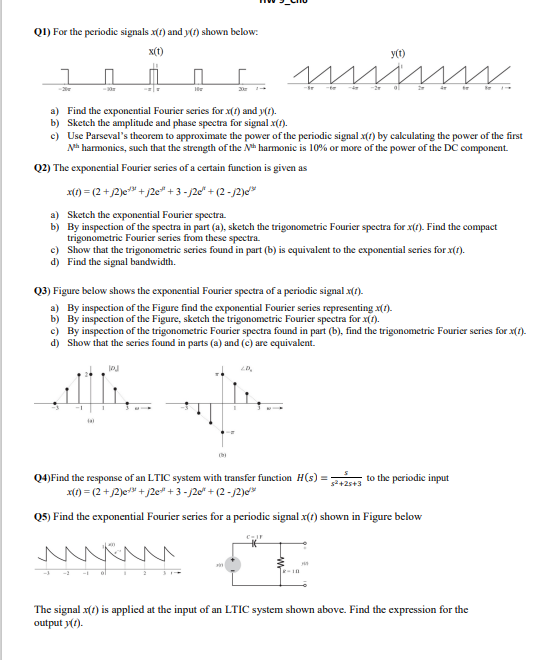QI) For the periodic signals x(f) and y() shown below: a) Find the exponential Fourier series for x(1) and y(1). b) Sketch the amplitude and phase spectra for signal x(f). c) Use Parseval's theorem to approximate the power of the periodic signal x(1) by calculating the power of the first N* harmonics, such that the strength of the N harmonic is 10% or more of the power of the DC component.
QI) For the periodic signals x(f) and y() shown below: a) Find the exponential Fourier series for x(1) and y(1). b) Sketch the amplitude and phase spectra for signal x(f). c) Use Parseval's theorem to approximate the power of the periodic signal x(1) by calculating the power of the first N* harmonics, such that the strength of the N harmonic is 10% or more of the power of the DC component.
Introductory Circuit Analysis (13th Edition)
13th Edition
ISBN:9780133923605
Author:Robert L. Boylestad
Publisher:Robert L. Boylestad
Chapter1: Introduction
Section: Chapter Questions
Problem 1P: Visit your local library (at school or home) and describe the extent to which it provides literature...
Related questions
Question
Question 1 ?

Transcribed Image Text:QI) For the periodic signals x(f) and y(f) shown below:
х()
y(t)
-Sr
-te
e
a) Find the exponential Fourier series for x(1) and y(1).
b) Sketch the amplitude and phase spectra for signal x(f).
c) Use Parseval's theorem to approximate the power of the periodie signal x(1) by calculating the power of the first
N* harmonics, such that the strength of the Nh harmonic is 10% or more of the power of the DC component.
Q2) The exponential Fourier series of a certain function is given as
x() = (2+2)e" + j2e* + 3 - /2e" + (2 - /2)c*
a) Sketch the exponential Fourier spectra.
b) By inspection of the spectra in part (a), sketch the trigonometric Fourier spectra for x(t). Find the compact
trigonometric Fourier series from these spectra.
c) Show that the trigonometric series found in part (b) is equivalent to the exponential series for x(f).
d) Find the signal bandwidth.
Q3) Figure below shows the exponential Fourier spectra of a periodic signal x(r).
a) By inspection of the Figure find the exponential Fourier series representing x(1).
b) By inspection of the Figure, sketch the trigonometric Fourier spectra for x(1).
c) By inspection of the trigonometric Fourier spectra found in part (b), find the trigonometric Fourier series for x(1).
d) Show that the series found in parts (a) and (c) are equivalent.
Q4)Find the response of an LTIC system with transfer function H(s) =
x(1) = (2 +2)e*" + j2e* + 3 - j20" + (2 - j2)e*
to the periodic input
s+2s+3
Q5) Find the exponential Fourier scries for a periodic signal x(t) shown in Figure below
The signal x(1) is applied at the input of an LTIC system shown above. Find the expression for the
output y().
Expert Solution
This question has been solved!
Explore an expertly crafted, step-by-step solution for a thorough understanding of key concepts.
This is a popular solution!
Trending now
This is a popular solution!
Step by step
Solved in 3 steps with 2 images

Knowledge Booster
Learn more about
Need a deep-dive on the concept behind this application? Look no further. Learn more about this topic, electrical-engineering and related others by exploring similar questions and additional content below.Recommended textbooks for you

Introductory Circuit Analysis (13th Edition)
Electrical Engineering
ISBN:
9780133923605
Author:
Robert L. Boylestad
Publisher:
PEARSON

Delmar's Standard Textbook Of Electricity
Electrical Engineering
ISBN:
9781337900348
Author:
Stephen L. Herman
Publisher:
Cengage Learning

Programmable Logic Controllers
Electrical Engineering
ISBN:
9780073373843
Author:
Frank D. Petruzella
Publisher:
McGraw-Hill Education

Introductory Circuit Analysis (13th Edition)
Electrical Engineering
ISBN:
9780133923605
Author:
Robert L. Boylestad
Publisher:
PEARSON

Delmar's Standard Textbook Of Electricity
Electrical Engineering
ISBN:
9781337900348
Author:
Stephen L. Herman
Publisher:
Cengage Learning

Programmable Logic Controllers
Electrical Engineering
ISBN:
9780073373843
Author:
Frank D. Petruzella
Publisher:
McGraw-Hill Education

Fundamentals of Electric Circuits
Electrical Engineering
ISBN:
9780078028229
Author:
Charles K Alexander, Matthew Sadiku
Publisher:
McGraw-Hill Education

Electric Circuits. (11th Edition)
Electrical Engineering
ISBN:
9780134746968
Author:
James W. Nilsson, Susan Riedel
Publisher:
PEARSON

Engineering Electromagnetics
Electrical Engineering
ISBN:
9780078028151
Author:
Hayt, William H. (william Hart), Jr, BUCK, John A.
Publisher:
Mcgraw-hill Education,